Antenna and tower work are never far from our minds as hams. Most amateur loads are considered light by professional installers, but they can be heavy enough to cause injuries if mishandled or poorly secured. This article is an overview of ropes, knots, and slings which are used by hams. Since most of us are not professionals, it’s always a good idea to review and brush up our skills before “game day.”
Two complementary resources are sold by DX Engineering: “Up the Tower” by K7LXC and the ARRL’s “Antenna Towers for Radio Amateurs” by K4ZA. The first features a lot of information on rigging, including ropes, slings, and tools. The second discusses how to properly build a tower system. You should review both of these references, which go into far more detail than this article.
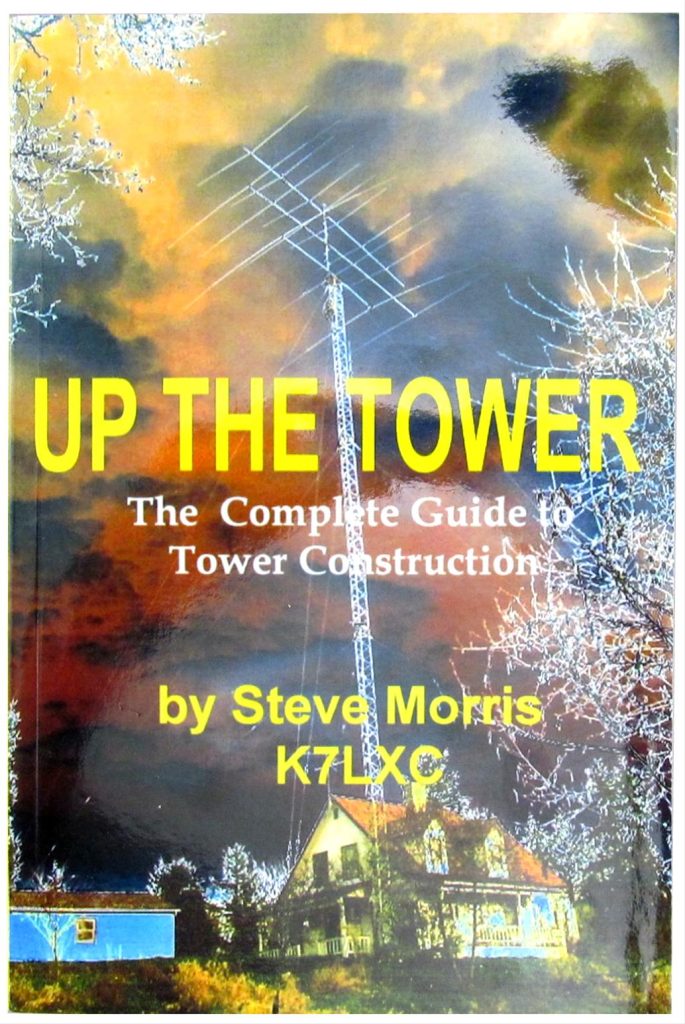
OnAllBands also features an excellent five-part series, “Amateur Radio Tower Safety,” featuring W3YQ. Please be safe when climbing and working aloft. Take advantage of the excellent training material that is available to you!
Lifting & Lowering
Except for the lightest loads, always use a suitably rated pulley or block when raising and lowering items. Avoid the small hardware store pulleys that are not rated for heavy loads. Light-duty hardware is often stamped or labeled as unsuitable for climbing and lifting—heed that warning!
The snatch block is the most useful since the rope does not have to be threaded through the pulley—one side opens so the pulley can be placed directly on the rope, even when it is tied off at both ends. This is called “snatching the rope.”
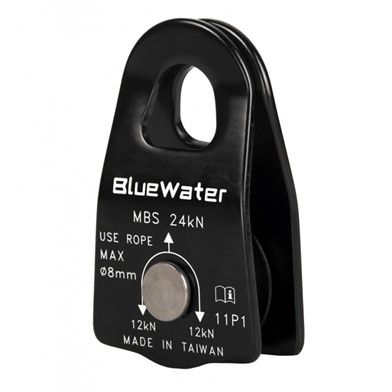
The snatch block pulley shown in the photo is rated at a working load of 24 kN (kilo-Newtons), which is about 5,400 lbs. Marine and construction pulleys are also available, although they weigh more. Get pulleys with sheaves that fit your rope so it can’t slip and jam between the sheave and body of the pulley. Watch for sales and have a few pulleys in your tool kit.
Rope
For basic tower and antenna work, Dacron and nylon ropes are preferred. A kernmantle rope has a braided sleeve that protects the rope’s core. For tower work, use a 3/8 or 1/2 inch rope because they can handle heavy loads and are easier on your hands than thinner ropes. Inexpensive polypropylene rope is useful for light lifts—such as the tool bucket or a rotator. Wear sturdy gloves when working with a rope under load so that if the load slips, your hands won’t be burned from friction.
Remember that to lift something to a certain height, you’ll need at least twice that length of rope, and another 50% of length is recommended. Try to have at least two load-rated ropes available.
There are two strength ratings for rope: breaking strength and working load limit. The breaking strength is usually three times the working load rating. Try not to use ropes near or at their load limit.
Using ropes as temporary guys should be done with caution and rarely, if ever, as permanent guys. Stretching varieties, such as nylon, should never be used as a guy line. Use a low-stretch rope material, such as Dacron, and be sure it is well within its load limit.
Knots
There are many, many types of knots and you should find a how-to book or website that shows how to tie the basic knots. If you’re a beginner, some essential knots are demonstrated on the Columbus McKinnon YouTube channel. This site is about entertainment rigging, which is a lot like basic ham radio rigging! For more advanced knots, resources such as animatedknots.com show you exactly how to tie knots (it also includes a beginner’s section).
The most common types of knots used in antenna and tower work are hitches that pull on or lift tubing and tower sections. The below photo shows two half hitches:
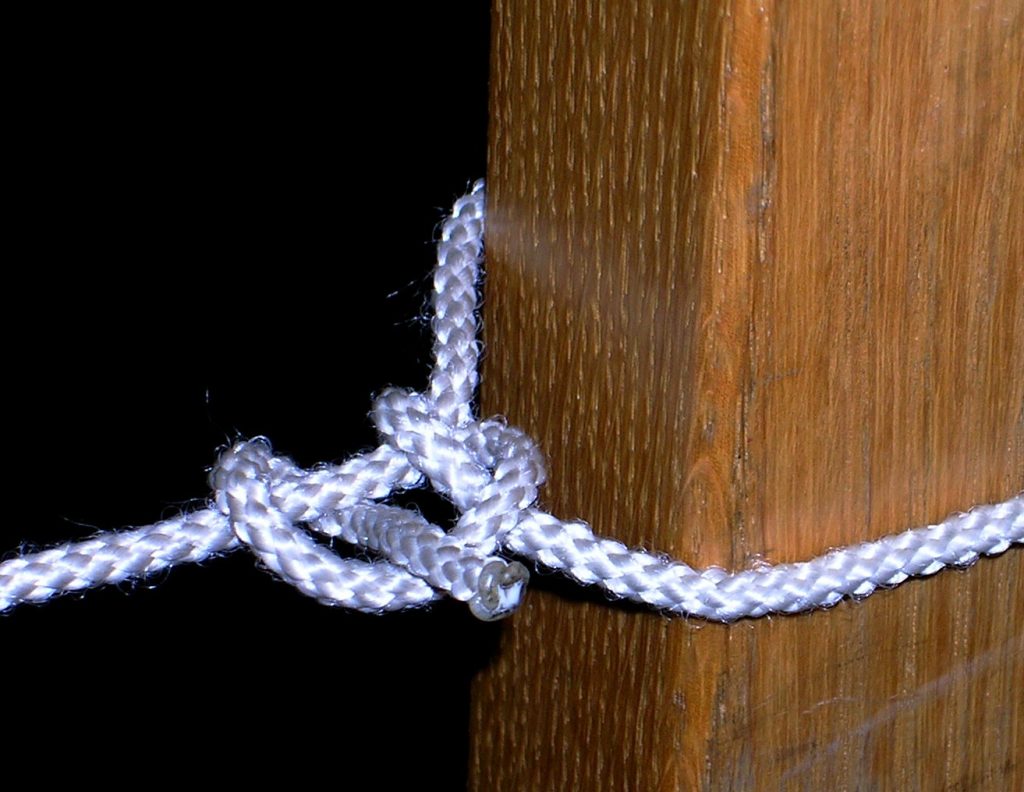
Another common knot is the bowline, which is very useful because it doesn’t slip and can be untied relatively easily, even after being used with a heavy load. I use it for tying ropes to antenna insulators because I can untie a bowline even after the rope has been out in the weather for months.
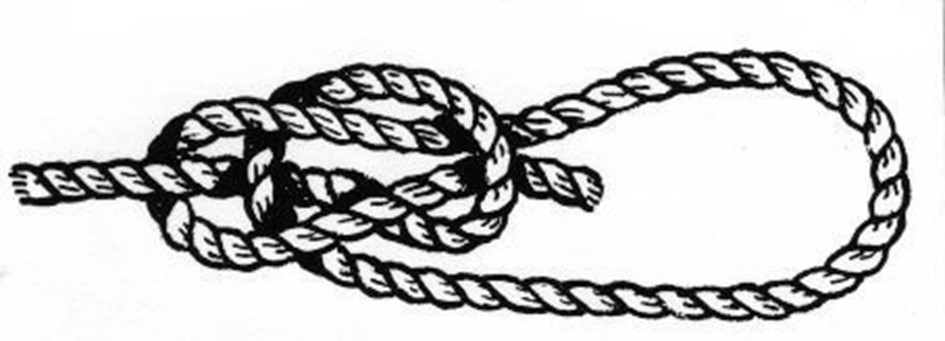
There are lots and lots of instructions for how to tie a bowline. Many of us of a certain age learned the “make a hole next to the tree, the rabbit comes up through the hole, goes around the tree, and back in the hole” method. This video, however, is probably easier to learn! You might also try to learn the one-handed bowline so you can tie a secure knot with one hand while the other is holding a load—a not unusual situation aloft.
Carabiners
To attach a rope to a structure, a climbing harness, or other rope, carabiners are often used. An assortment is shown in the photo below.
Clockwise from top left are a D shape wire gate, straight gate, oval shape straight gate, auto lock, and twist lock. The straight gate versions are the most common in antenna and tower work.
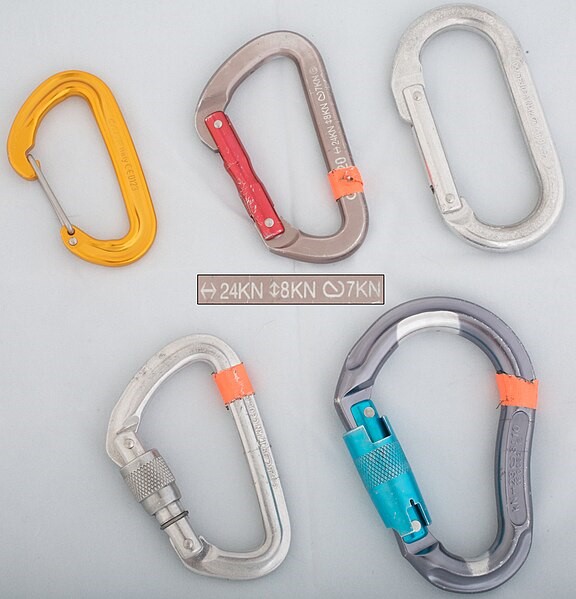
Note the load ratings in the middle. The highest rating of 24 kN is the breaking load with the gate closed. The working load is one-third of the breaking rating. The smallest value is the maximum load with the gate open. Lightweight clips that look and act like carabiners are often sold as keychains or hangars but should never be used for lifting loads! They are stamped with warnings showing they are not to be used for load lifting.
Slings
Rather than tie a rope directly to the workpiece, a synthetic web sling is much more convenient to use. Visit Hoistwire.com for images of various web slings, including common types such as the endless sling and those with eyes at the end. There are also rope, wire rope, and chain slings, but those are not often used for ham radio jobs.
For a complete table of single-ply web sling ratings, see Table 22 “Rated Load for Two-Ply, Class 5 Synthetic Webbing Slings Expressed in Pounds” here: OSHA.gov.
The three most basic uses of slings are straight, choker, and basket as displayed at PracticalMaintenance.net, which shows many ways of using slings and how to determine the load rating of each method.
An assortment of web slings comes in handy for antenna and tower work. Most lifts will use slings from 18 to 36 inches long. One inch wide slings will handle nearly all antennas. A pair of 36 inch slings configured as a bridal hitch make a stable and strong way to lift a Yagi boom. I recommend having at least two slings of several lengths.
If you plan on lifting a tower with a boom truck or crane, use heavier slings that are two inch wide or more. Consult with the crane operator first.
Storage and Maintenance
Finally, you really need to take good care of anything you depend on for safely working on antennas and towers! After the job is done, lower your ropes into a plastic milk crate or bucket. The rope won’t tangle and will then pull out easily without kinking or knotting. Larger and longer ropes can be wound on a portable hose reel.
As you store ropes and slings, inspect them carefully for chafing or cutting that may have occurred in use. Look for carabiner gates that are twisted or won’t latch securely. Damage beyond superficial wear is enough to warrant replacement.
If your crew is going to be bringing some of their own gear, label your stuff! A permanent marker will help you keep your gear separate from that of others. Colored tape will also make it easy to tell everyone’s stuff apart.
Ropes and slings need to be kept clean, dry, and away from where rodents and insects can get at them. Avoid kinks and sets by making sure there are no tight knots or bends in storage. Keep them away from oil and grease that might degrade the fibers.
Take care of your gear and it will take care of you!
Editor’s Note: DX Engineering carries a variety of rope in a range of diameters and break strengths, along with rope hardware kits to work with different sizes of Mastrant rope.

